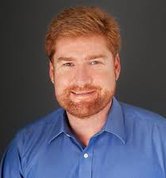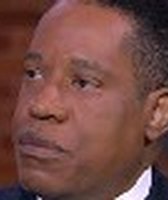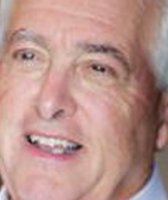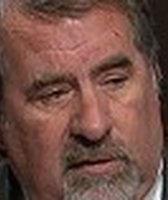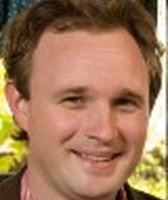Stand up for the facts!
Our only agenda is to publish the truth so you can be an informed participant in democracy.
We need your help.
I would like to contribute
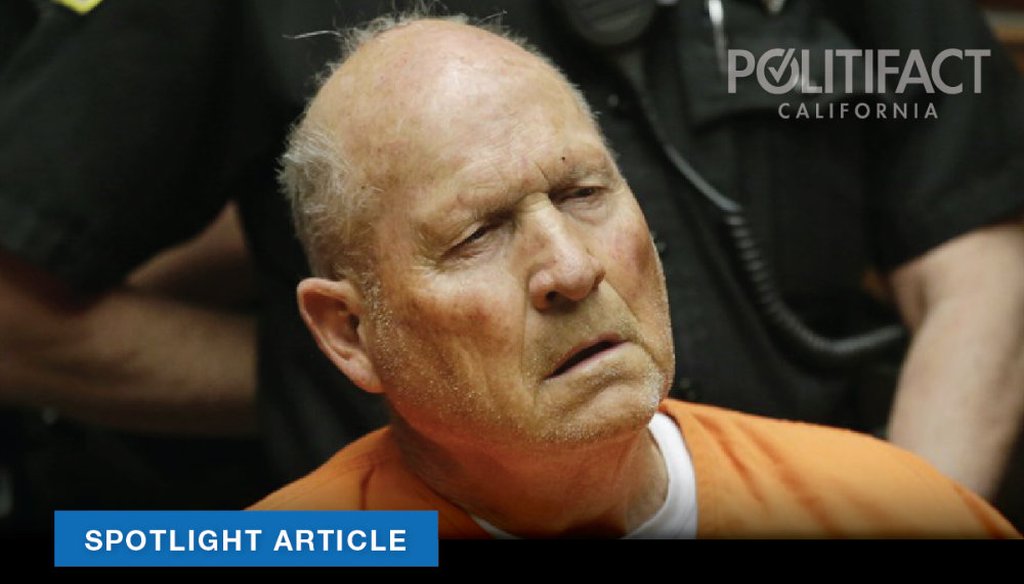
A recent TV campaign ad made claims about the Golden State Killer case. Graphic by Capital Public Radio
Days after authorities arrested a suspect in the Golden State Killer case, the campaign to re-elect Sacramento County District Attorney Anne Marie Schubert produced a TV ad celebrating the break in the decades-old case.
"We found the needle in the haystack, and it was right here in Sacramento," Schubert says in the ad, the footage lifted from a press conference where police and prosecutors announced the arrest of Joseph James DeAngelo.
DeAngelo, 72, is the former police officer charged with killing eight people in Sacramento, Ventura and Orange counties. Investigators said they also linked him to nearly 50 rapes and three attempted sexual assaults from 1976 to 1986.
Prosecutors said they used DNA and a genealogical website to identify DeAngelo decades after the case had gone cold, an approach initiated by a longtime Contra Costa County investigator.
Schubert’s experience on DNA cases is a key part of the TV advertisement.
TV ad by Schubert For District Attorney campaign.
RELATED: Visit here for Capital Public Radio's full coverage of the Golden State Killer case.
In the ad, a narrator describes Schubert as "a groundbreaking DNA expert."
He adds: "Schubert led the investigation that solved the Golden State Killer East Area Rapist case."
That statement is followed by short clips of TV news anchors describing a break in the case and Schubert’s statement about finding "the needle in the haystack."
Finally, the ad ends with the narrator saying: "Tough, fair, independent. District Attorney Anne Marie Schubert. She protects us."
The claims that Schubert is "a groundbreaking DNA expert" and "led the investigation that solved" the probe caught our attention.
Are they factual?
Here’s what we found:
The ad includes flashy video of a rotating DNA strand, the kind made popular on TV shows such as CSI. A narrator then describes Schubert as a "groundbreaking DNA expert."
But Schubert isn’t considered a DNA expert, at least not in a scientific sense, according to Ruth Dickover, director of the UC Davis Forensic Science Graduate Program.
"I think that what she’s saying is she’s an expert at prosecuting DNA cases," said Dickover, who spent nearly 10 years as a criminalist at the DNA Analysis Unit at the Kern County Regional Crime Lab.
Crime lab employees who specialize in DNA must pass proficiency tests and be able to interpret results from DNA testing. A district attorney who prosecutes DNA cases wouldn’t have those qualifications, Dickover said.
Former District Attorney Jan Scully, who retired after two decades and hand-picked Schubert to succeed her in 2014, agreed Schubert doesn’t analyze DNA in a laboratory the way forensic scientists do.
"On the other hand, for her it’s not just about prosecuting cases," Scully said. "She actually understands this stuff and has done presentations with criminalists and, in my opinion, would be considered one of the top prosecutors in the state, at least this state, for purposes of understanding not just how to put a case together but actually understanding DNA."
On the term "groundbreaking," Scully pointed to a first-of-its-kind case in 2000 in which Schubert, then a deputy district attorney, obtained a warrant for a man who left his DNA behind during a rape in 1994. Schubert received the so-called "John Doe" warrant using only the man’s DNA and no other identifying information. The move allowed prosecutors to just barely beat a six year statute of limitations deadline. A year later, there was an arrest after a DNA match was completed.
"It should be noted — after the John Doe warrant was issued, I was contacted by law enforcement from all over the country on how to do this," Schubert wrote on a resume provided by her campaign.
Her resume includes speaking roles at numerous cold case symposiums and DNA workshops over the past decade. She also wrote chapters in two books on these topics.
News reports, information from Schubert’s campaign and from Scully indicate Schubert did, in fact, take a leading role in the investigation. Of course, that doesn’t mean she was the only one to keep the probe alive.
In 2000, Schubert formed a cold case unit in the Sacramento County DA’s office. The goal, Scully said, was to identify and solve old cases where DNA was present. In this role, Schubert coordinated with law enforcement officials and followed up on potential leads in the East Area Rapist case, Scully added.
Schubert also reached out to and collaborated with Paul Holes, an investigator with the Contra Costa County District Attorney’s Office, who spent more than two decades investigating the case.
Two years ago, Schubert convened a task force on the 40th anniversary of the attacks in the Sacramento suburbs. The group included investigators from counties in Southern California, the San Francisco Bay Area and the FBI. Her campaign acknowledged Schubert worked "with many other investigators over the years."
Noah Phillips, a Sacramento County deputy district attorney who is challenging Schubert for re-election, said the ad shows Schubert taking credit for the work of others. He added that Holes "deserves the lion’s share of credit" for the arrest in the case.
In The Daily, a New York Times podcast, Holes detailed his work on the case stretching back to 1994. He described using then-emerging DNA technology to merge separate cases across California into the Golden State Killer case.
Years after the case had gone cold again, Holessaid in 2008 that he dove back into it: "Since that time, I have been working on this case 24-seven, 365," he said.
Holes said he took a new approach by creating an undercover profile on an open-source geneological website. That helped narrow the pool of suspects and eventually led to DeAngelo’s arrest.
Holes’ important role in the case is clear. But it’s not just Schubert’s campaign and her former boss who describe the district attorney as a leading figure in the case.
Monica Miller, who was in charge of the Sacramento FBI field office from 2013 to 2017, told The New York Times that Schubert "was central in leading this, convincing people this was worth pursuing," referring to the renewed focus on the case.
This part of the ad is open to interpretation. Given the recent arrest, we can imagine many agreeing the case is, indeed, "solved." We can also understand critiques because the case hasn’t made its way through the legal system and there’s been no conviction.
Here’s how Scully said she interprets the term "solved": "Solved is figuring out who did it and actually being able to make an arrest. So [if] you solve a crime, it’s very different from taking it into court and getting a conviction."
Some cold cases are solved but never lead to a conviction, the former DA said, because they are so old that a suspect or key witness has died.
"From our common vernacular, solved means you basically figured it out and you know who’s responsible," she added.
The claims in the ad, however, do not use the term suspected or alleged killer, giving some the possible impression that a verdict has been reached and the case is closed.
The ad could have easily described Schubert as leading the team that arrested and charged the Golden State Killer.
A 2017 case in Oregon could give some pause about whether the case is really solved. In that instance, investigators searching for the East Area Rapist also scoured genetic websites but misidentified an Oregon man as a potential suspect, according to the Associated Press. Investigators this month said they’re confident that, after using a similar technique, they truly found the serial rapist and killer.
Phillips, the challenger in the DA race, said he expects the defense team will challenge investigators’ collection of DNA, potentially complicating the case.
"I think the story of what happens to the East Area Rapist, from a legal perspective, is just beginning," he added.
Our Sources
Schubert for District Attorney, TV campaign ad, May 2018
David Gilliard, campaign spokesman for Schubert, email exchange, May 2, 2018
Anne Marie Schubert resume, provided by Schubert campaign, accessed May 2018
Ruth Dickover, director, UC Davis Forensic Science Graduate Program, May 2, 2018
Noah Phillips, candidate for Sacramento County District Attorney, interview May 3, 2018
Jan Scully, retired Sacramento County District Attorney, interview May 2, 2018
Capital Public Radio, After Four Decades, Golden State Killer Suspect Arrested In Sacramento, April 25, 2018
CNN.com, Indicting John Doe: When all you have is DNA, Dec. 31, 2007
New York Times podcast, The Daily, May 4, 2018
New York Times, How a Genealogy Site Led to the Front Door of the Golden State Killer Suspect, April 26, 2018
Sacramento Bee, Here's the inside story of how police nabbed the East Area Rapist suspect, April 29, 2018
Sacramento Bee, East Area Rapist, the case that haunted a prosecutor – until now, April 26, 2018
Associated Press, Golden State Killer search led to wrong man in 2017, April 27, 2018
